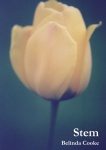
Describing her first collection, Inventory (2008), Linda Black drew a parallel between her writing style and her approach to etching. ‘As a visual artist (and art teacher),’ she said, ‘my process was to begin without a preconceived idea—to approach a blank sheet, or etching plate, by merely making a mark, with as it were a blank mind, to delight in the not knowing, the exploration, the opening up of possibilities.’ A matching openness to where words might lead characterised that first collection, and has been a hallmark of her poetry ever since. With each new volume, her writing seems to take more risks, the most recent book, Then, continuing this trajectory.
Memories, domestic objects, children’s games, fairytales, and the doubtful wisdom of common sayings are all grist to Black’s process. Word associations, puns, rhymes and alliterations are allowed to lead, the poem discovering itself as it goes along. ‘Call my refrain a form/of recitation ……. my favourite/polyphony’ she writes in ‘The thrum string strain’.
There are echoes of Gertrude Stein’s Tender Buttons in some of the poems, for example in phrases like: ‘Suppose it is done and frequent as the moth’, ‘stuck lift/when there is kindness/a solid spoon’, and ‘Concerning cutlery were canteens.’ Like Stein, Black often focuses on the domestic: clothing, food, washing, household items. One section of Then, called ‘Frippery…’, groups poems about dress, including the delightful ‘What she is wearing today she may not have’. The second paragraph reads:
Slipped on the shoe. Many laced and pin-tucked as featured. Browse for the time being. Snag a caught loop on a chain. There are many ways to travail for example on the slide without a care. Never having driven nor for that matter the length of a thread. Forewarned is to dangle, toes tapping.
Travailing ‘on the slide’ might be a description of Black’s own work method. Anna Reckin speaks to this in her back-cover endorsement of Then:
Words ‘collude / allude’, slip over each other, with many near-misses. They lean into one another, threaten connection, narrowly miss and ricochet in another direction. Allusions are so nearly (neatly-delightfully) pinned down, are always on the verge of escaping.
In the book’s next section, ‘The un-envisaged…’, we find poems reference eating and the kitchen. ‘A smidgen’ makes extensive use of typographical devices in its witty celebration of gluttony. The poem begins:
Of fudge a…
screa m of carrion fat-lipped drained
of FANCY a st0rm
in a st0mach walls str-e-e-e-tch
churn regurgitate just a little
bit MORE salvation: latkes tzimmus
(Latkes are potato pancakes, and tzimmus presumably refers to tzimmes, a kind of stew of vegetables and dried fruit.)
Another poem of note, which comes in the final section, is ‘A Causeway Runneling Between Two Lands Either Side of a Parting’, a long prose piece which riffs on the tropes of Medieval Romance literature. Fortunate is kind of a knight errant, a ‘traveller’ who knows well ‘in which direction lies pleasure & fervour, rest & a full stomach.’ ‘Tralalee, tralalee,’ he sings, ‘this is my domain.’
But Fortunate’s sense of entitlement is challenged later in the poem by a mocking authorial voice. ‘Sort yourself out!’ it admonishes. ‘The world is not a shellfish!’ ‘The water is furring, the air is hardening, a storm is nigh,’ the voice warns. ‘Fuel is eating the planet. To go by foot is honourable. When it comes to tomorrow: Then!’
The collection includes several grid poem, some of them reading like skipping rhymes. I particularly like ‘Lark’, the title capturing the poem’s ludic approach:
Folly me dandy Follow me rare
Up from the broad room Down for repair
Clopped in the cow-pat Snapped in the snare
Glandular fever Dip snip & dare
Influence effluence Stock still & stare
Safety-pin paraffin Polish & swear
Pickle & candy Cauliflower pear
As well as engaging in this kind of childlike play, Black’s poetry can also address more personal and difficult subjects. A section near the beginning of the book, ‘Misdemeanour’, includes poems about Black’s deceased parents, the mood here far more sombre. In ‘Mother’ she writes of a parent about whom she clearly has conflicted feelings, a mother ‘with the perfect/script’, a ‘quite comfortable/off mother fed/to the teeth’, a ‘flat iron mother/about faced’.
In ‘He lay down…’ she compares her aging father to a ‘dormant parasol […]/its skirts/declined limp all life/gone out of them’. The final poem of this section, ‘I like’, says of her father’s death:
if it was up to me
I’d deem you well
alive and well
and sitting opposite
There is a great deal of variety in this engaging collection, both in form and theme. Black’s playful, quizzical, at times elusive poetry is well worth getting to know if you’re not already familiar with it.
Simon Collings 27th June 2021









